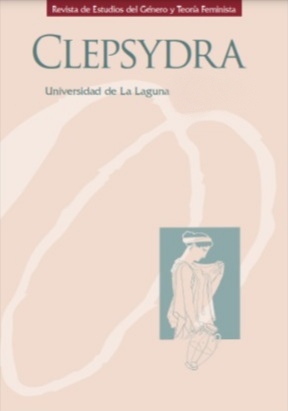Reformulating the Riot Grrrl movement: Space and sisterhood in Kathleen Hanna’s lyrics
Resumen
La música se ha convertido en un espacio en el que debatir temas como el género, la identidad o la igualdad. Con este trabajo pretendo llevar a cabo un análisis crítico del discurso con perspectiva feminista de las letras de canciones de Kathleen Hanna (1968-), cantante y compositora americana, pionera del movimiento punk y figura principal del movimiento Riot Grrrl. Cubriendo temas relevantes relacionados con la condición de las mujeres, las letras de Hanna sitúan temas relacionados con el género en primera línea y se convierten en un medio significativo para reclamar el feminismo en la música underground. Para mi estudio prestaré atención a las ocasiones en las que las letras de Hanna en Bikini Kill y Le Tigre muestran una interpretación del espacio y la sororidad y, con ello, analizaré la invisibilidad de las mujeres en la música underground y ampliaré el entendimiento social y cultural de la misma.
Citas
Alonso Alconada, Soraya and Chaparro Sainz, Ángel. “Punk Pioneers: Chicana Alice Bag as a Case in Point.” Lectora, 23 (2017), pp. 83-98.
Attali, Jacques. Noise: The Political Economy of Music. Minessota: University of Minnesota Press, 1985.
Barton, Laura. “Grrrl power.” The Guardian, March, 2009 (https://www.theguardian.com/lifeands-tyle/2009/mar/04/grrrl-power-music).
Bikini Kill. Yeah Yeah Yeah Yeah. Kill Rock Stars, 1993. CD.
Bikini Kill. Reject All American. Kill Rock Stars, 1996. CD.
Carson, Mina, Lewis Tisa and Shaw, Susan M. Girls Rock!Fifty Years of Women Making Music. Kentucky: University Press of Kentucky, 2004.
Chidgey, Red. “Riot Grrrl Writing,” in Monem, Nadine (ed.), Riot Grrrl. Revolution Girl Style Now!, London: Black Dog Publishing, 2007, pp. 100-145.
Corrigan, Suzy. “Art, Politics and How One Grrrl Joined the Feminist Timeline,” in Monem, Nadine (ed.), Riot Grrrl. Revolution Girl Style Now!, London: Black Dog Publishing, 2007, pp. 145-168.
Ditto, Beth. “Foreword,” in Monem, Nadine (ed.), Riot Grrrl. Revolution Girl Style Now!, London: Black Dog Publishing, 2007, pp. 8-9.
Downes, Julia. “Riot Grrrl: The Legacy and Contemporary Landscape of DIY Feminist Cultural Activism,” in Monem, Nadine (ed.), Riot Grrrl. Revolution Girl Style Now!, London: Black Dog Publishing, 2007, pp. 12-52.
Ewens, Hannah. “Riot Grrrl Pioneers Bikini Kill: ‘We’re Back. It’s Intense’.” The Guardian, June, 2019 (https://www.theguardian.com/music/2019/jun/09/bikini-kill-riot-grrrl-were-back-its-intense).
Frith, Simon. Taking Popular Music Seriously: Selected Essays.Farnham: Ashgate Pub Co., 2007.
Garrigos, Cristina, Triana, Nuria and Guerra, Paula. God Save the Queens: Pioneras del Punk. Barcelona: 66rpm ediciones, 2019.
Hamilton, Heidi E. and Schiffrin, Deborah (eds.). The Handbook of Discourse Analysis, West Sussex: Wiley Blackwell, 2015, pp. 466-485.
Hanna, Kathleen. “Gen X Survivor: From Riot Grrrl Rock Star to Feminist Artist,” in Morgan, Robin (ed.), Sisterhood Is Forever. The Women’s Anthology for a New Millenium. New York: Washington Square Press, 2003, pp. 131-137.
Hanna, Kathleen. “Herstory Repeats.” Old Dominion University Norfolk, VA: Guest Lecture, 2011 (https://www.youtube.com/watch?v=NcmIjU2dR-E).
Hanna, Kathleen. “My Herstory.” (http://www.letigreworld.com/sweepstakes/html_site/fact/khfacts.html).
Hiroshi Garrett, Charles. Struggling to Define a Nation: American Music and the Twentieth Century. Berkeley: UC Press, 2008.
Holmes, Janet and Meyerhoff, Miriam. The Handbook of Language and Gender. Oxford: Blackwell Publishing, 2003.
Kendall, Shari and Tannen, Deborah. “Discourse and Gender,” in Tannen, Deborah, Hamilton, Heidi E. and Schiffrin, Deborah (eds.), The Handbook of Discourse Analysis, West Sussex: Wiley Blackwell, 2015, pp. 639-660.
Kotarba, Joseph A. and Vannini, Phillip. Understanding Society Through Popular Music. New York /Oxon: Routledge, 2008.
Lazar, Michelle M. “Feminist Critical Discourse Analysis: Articulating a Feminist Discourse Praxis.” Critical Discourse Studies, 4: 2 (2007), pp. 141-164.
Le Tigre. Le Tigre. Mr. Lady Records, 1999. CD.
Le Tigre. Feminist Sweepstakes. Mr. Lady Records, 2001. CD.
Le Tigre. This Island.Universal Records, 2004. CD.
Letigreworld. (http://www.letigreworld.com/sweepstakes/f lash_site/fact/fact.html).
Litosseliti, Lia and Sunderland, Jane. Gender Identity and Discourse Analysis. Discourse Approaches to Politics, Society and Culture. Philadelphia: John Benjamins Publishing Company, 2002.
Marcus, Sara. Girls to the Front: The True Story of the Riot Grrrl Revolution. New York: Harper Perennial, 2010.
McClary, Susan. Feminine Endings. Minneapolis: University of Minnesota Press, 1991.
McDonnell, Evelyn and Vincentelli, Elisabeth. “Riot Grrrl United Feminism and Punk. Here’s an Essential Listening Guide.” Nytimes, May, 2019 (https://www.nytimes.com/interac-tive/2019/05/03/arts/music/riot-grrrl-playlist.html).
Monem, Nadine (ed). Riot Grrrl. Revolution Girl Style Now!. London: Black Dog Publishing, 2007.
Most excellent songs of every year since 19 67. (http://archive.li/mjtkj).
O’Brien, Lucy. She Bop. The Definitive History of Women in Popular Music. London: Jawbone Press, 2012.
Raha, Maria. Cinderella’s Big Score. Women of the Punk and Indie Underground. Berkeley: Seal Press, 2005.
Reddington, Helen. The Lost Women of Rock Music. Female Musicians of the Punk Era. Sheffield: Equinox Publishing, 2012.
Van Dijk, T.A. “Critical Discourse Analysis,” in Tannen, Deborah, Hamilton, Heidi E. and Schiffrin, Deborah (eds.), The Handbook of Discourse Analysis, West Sussex: Wiley Blackwell, 2015, pp. 466-485.

Esta obra está bajo licencia internacional Creative Commons Reconocimiento-NoComercial-SinObrasDerivadas 4.0.
Los artículos son propiedad de sus respectivos autores y autoras, quienes conceden libremente a la revista el derecho de primera publicación.


